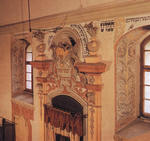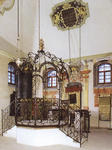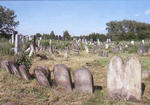
Holesov is a small town in the Czech Republic in South Moravia in the Kromeriz district. Population of this town is about 15,000. It lies on the divide of Hana and Valassko on the left bank of the Rusava River. It was known at the time of the coming of the Slavs and is mentioned throughout history.
In 1131 Holesov is first mentioned in writing and about 1272 it became a town.
A Separate Jewish quarter was established in 1454. The Jews were kindly invited by the owners of Holesov, the Sternberks, to build their quarter north of the town. The Sternberk family owned the town till 1574, when it became the property of the Lichtenburgs. In 1589 Holesov was bought by Karel Starsi of Zerotin.
In 1604 - with the new owners, the Lobkowitz family, came a period of recatholicization led by
the Jesuit priest Jan Sarkander. 1621 - 1627 Holesov was plundered and burnt down by the rebellious locals. 1643 - 1645 the Swedish occupation. After 1650 Holesov became the centre of a large estate owned by the Rottals and in 1762 it was taken over by families related to them. Around 1850 Holesov became a fast developing town with a lively cultural and political life. The first German secondary technical school, founded in 1872, was changed to a Czech one in 1888. In 1882 first train arrived in Holesov.
Earliest known Jewish community was after 1454. The 1939 Jewish population was 328. 1726 transfer; pogroms in 1774, 1850, 1899 and 1918; self-standing political community 1850-1919 were events effecting the community. Rabbi Sabbatai

ben Meir ha-Kohen (Sach), 1622-1662, lived and is buried here. The Jewish cemetery originated in second half of the 15
th century with last known Conservative Jewish burial in 1975.
Landmaked cemetery.
Other towns or villages used site. A Czech sign or plaque mentions the Jewish Community, famous individuals buried in cemetery and marks. The flat isolated suburban site by water has
Jewish symbols and inscriptions in Hebrew on the gate or wall. Reached by turning directly off a public road, access is open to all via a continuous masonry wall and non-locking gate. The pre- and post-WWII size of cemetery is 0.819 ha. 500-5000 stones, all in original locations, date from 1670-20
th century. The marble, granite, limestone and sandstone flat shaped stones, finely smoothed and inscribed stones, flat stones with carved relief decoration, double tombstones, multi-stone monuments or obelisks have Hebrew, German and Czech inscriptions. Some have traces of painting on their surfaces, iron decorations or lettering, bronze decorations or lettering, and or metal fences around graves. The cemetery contains no special memorial monuments.
Within the limits of the site are a pre-burial with wall inscriptions-painting house [sic] and an ohel. Muzeum Kromerizska v Kromerizi owns the site used only as a Jewish cemetery. Adjacent properties are agricultural and residential. Frequently, organized Jewish tours or pilgrimage groups and private visitors stop. Vandalism occurred occasionally 1945-1991.


 Guide
Guide 




